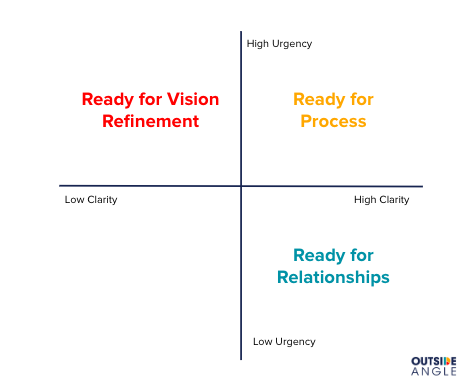Big ideas are inherently exciting. They offer a new way of thinking of an old problem, a more elegant solution to a persistent challenge, or create the ability to do something previous thought impossible. Yet by definition, they are imaginary; not easily translated from idea to reality. Some big ideas require technical strategies (think: creating an app, designing a production mechanism, leveraging existing tools). Some require adaptive strategies (think: learning, modifying behavior, shifting thinking). Most require a combination of both.
Big Ideas Get Stuck in Different States

Big ideas often come to our team in a variety of states that look something like the chart above. A big idea’s current state dictates not just how much time and energy we dedicate to helping leaders bring it to fruition, but where we prioritize our collective time and resource investment. For example, many leaders approach us with a very urgent need but only a vague idea of how to get there. In those cases, we dedicate some time to vision refinement work up front but emphasize process development as a top priority.
Other leaders approach us because their teams are motivated to change, but don’t know where to begin. In those cases, we focus on developing a clear, shared vision for process (an understanding of how the process will work) early in our work.
Finally, some leaders approach us with a bold idea that is clear in its vision but has yet to gain traction with key stakeholders. In those cases, we spend up front time researching and developing critical relationships designed to help the vision succeed, and test and refine the vision hypothesis accordingly.
Regardless of where we focus, we always follow four general phases of work: feasibility analysis, modeling & design, change strategy, and change implementation.

Four Phases to Put a Big Idea in Motion
The Feasibility Analysis
For some leaders, the right path forward seems obvious, but they just can’t get their team to follow them. For some, the problem is self-evident, but the solution is less so. And for others, there simply seems to be too much else going on to undertake the necessary steps forward. Each of these situations requires a period of diligence to fully understand and evaluate the current state of the vision, and we call this our “feasibility analysis” effort.
Rather than evaluating whether the big idea is possible in general, we spend time understanding the complex dynamics within and around the organization that could either facilitate or impede the idea’s success. If they appear to be overwhelmingly antagonistic, we may even recommend that the idea be put on hold until circumstances change. By the end of this phase, we have developed a thorough description of what we have learned, and what would be necessary for the idea to succeed.
Modeling & Design
In many cases, there is clear need for change, but either the destination isn’t clear or the path to get there is murky. In these cases, we begin by assessing the state of the vision hypothesis and possible paths forward. We examine the extent to which there are already shared underlying values or design principles, and if they are absent we undertake a process to help articulate them. If there are clear principles, we can move toward establishing a clear destination and mapping the possible ways to get there. This part of the process often faces many challenges — many of which reside in hearts and minds.
We often face three obstacles to progress in this phase:
- Thinking creative ideation should be limited. Sometimes when a destination is clear, people feel compelled to pick a way and go. Holding space for ideation is critical to finding not so much the best path, but the path that everyone can get on board with.
- Failing to bring stakeholders along on the vision for process. Once stakeholders are on board with the vision, leaders often think it’s up to them to select a path and proceed. Many are rudely awakened when their chosen strategy founders because the team is not clear or not on board.
- Skipping the design effort and jumping into strategy. Without shared clarity about how the process will proceed, and how the work will remain on track in the face of a VUCA environment or shifting context, it is often impossible to successfully move from vision to implementation.
Building Change Strategy
It is only when there is shared clarity about the destination and the operating principles (a vision for process) for how to reach that destination, that a team can is ready to get into the nuts and bolts of exactly how to proceed. This phase can be cathartic and exciting, but it can also lead to defensiveness or a general unwillingness to acknowledge the current reality as it really is.
As Peter Senge describes in The Fifth Discipline, the space between today’s reality and tomorrow’s vision is the space of creative tension. Like a rubber band being stretched, there is inherent pull toward maintaining the status quo. Because of that, being truly honest about the current reality is essential. Without that honesty, it is impossible to break the habits and traditions of today that are impeding progress toward the vision for tomorrow. It is this stage that so often demands the help of an independent third party, but where most organizations fail to seek support. And that is where great ideas go to die.
Strategy Implementation & Refinement
The Change Strategy phase leads to a roadmap for implementation that is clear, transparent, and perhaps most important of all: written down. But as Dwight Eisenhower observed of any battle, “plans are useless but planning is indispensable.” The point here is not to toss the roadmap as soon as it’s complete, but to hold it loosely. No plan can anticipate all possible variables, so it behooves leaders to assume that unexpected variables and scenarios will arise along the way.
What we need is not to plan for several possible scenarios up front, but to develop an intentional cycle that will help gather data on implementation progress and point toward opportunities for ongoing improvements along the way. The cycle approach creates stretches in which to get work done without worrying that the course will change from day to day, but it also doesn’t allow the work to proceed for its own sake without any meaningful feedback loop. We call this approach “sense and respond” (a term we borrowed from Netflix), and we describe our approach to the cycle in much more detail here and here.
How to Take Action
Wherever you fit on the continuum of change aspiration, it is always possible to make progress. In some cases, that progress means honing or shifting your vision based upon what is feasible within your current means. In many cases, it means starting where you are, and intentionally working on the balance of the effort—whether it be investing relationships or clarifying the process for your team—in a systematic way. Outside Angle helps clients of all sizes and across sectors to evaluate their status and build paths forward accordingly using this framework. Our team believes deeply in these phases as an effective, yet simple, way to organize and manage complex change of any kind.

